30 Common Sourdough Starter Problems [Sourdough Starter Troubleshooting]
This post may contain affiliate links.
Sourdough starter problems can arise at any time when establishing a sourdough starter. Being able to troubleshoot sourdough starter issues is important to ensure you maintain the healthiest starter possible. And a healthy sourdough starter is the foundation to great sourdough bread.
Here you'll find a list of the most 30 most frequently asked questions when creating a sourdough starter. I hope it helps you to develop a strong, active and bubbly sourdough starter that will bake you the most amazing bread.
These common questions have come from my Facebook Group of over 300,000 sourdough bakers, as well questions that have been emailed to me over the past few years. I hope these questions and answers help you in your own sourdough journey, whether you have a new sourdough starter or you're feeding an existing starter.
If you're looking for the most common sourdough bread problems, good news, you can find my sourdough bread troubleshooting guide here or perhaps you're interested in the weirdest sourdough questions ever asked!
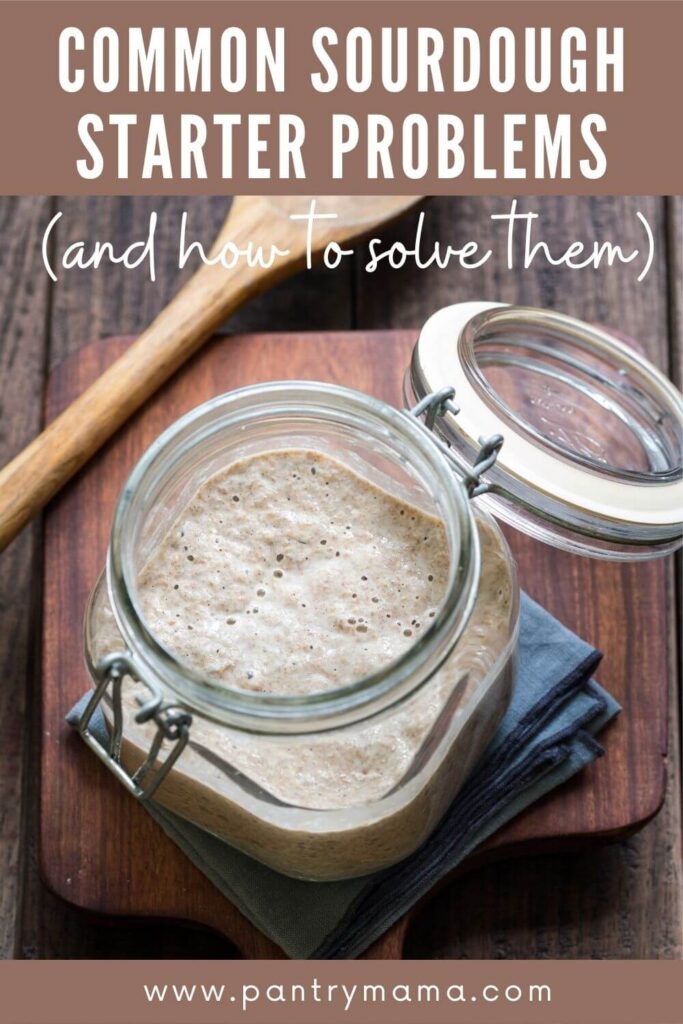
If you're in a rush, you might like to check out some of these quick sourdough FAQ posts that will help you get the best results from your sourdough starter:
- What is sourdough discard and is it the same as sourdough starter?
- How to keep sourdough starter warm?
- Why is my sourdough starter so runny?
- Have I killed my sourdough starter?
- Why is there liquid on top of my starter?
- Is there mold growing on my sourdough starter?
- Do I have to wash my sourdough starter jar?
- How To Get Bigger Bubbles in Sourdough Starter
Sourdough Starter FAQ & Most Common Problems
My sourdough starter seems really dry when I first feed it - do I need to add more water?
No you don’t! A stiffer sourdough culture is actually really good! As your mixture ferments, it will thin out and increase in volume, making it appear lighter & airier almost like a sponge!
If you're concerned, try feeding it and letting it sit for about 30 minutes, then stir it up again really well. This helps to incorporate all the flour.
Let your little SCOBY (symbiotic culture of bacteria & yeast) do the rest!
This is particularly pertinent if you're using whole wheat flour or rye rather than all purpose or bread flour for your starter.
Whole wheat flours absorb a lot more water, however you still need to use equal parts water and flour.
My Friend Told Me Not To Use Metal
There's a common misconception that metal is not to be used with sourdough starter or any sourdough mix. This is partly true, however, it really only refers to reactive metals like copper and aluminium.
It's safe to use regular stainless steel kitchen cutlery and utensils (like butter knives for stirring your starter for example). Stainless steel mixing bowls or bowls on top of scales are also safe for sourdough.
You just want to avoid using reactive metals with your sourdough starter (like copper and aluminium). This is because the acids (eg acetic acid) contained in your sourdough starter can react with the aluminium or copper and create toxic residues and metallic flavors in your starter or dough. But your stainless steel knife or spoon is fine to use with your sourdough starter.
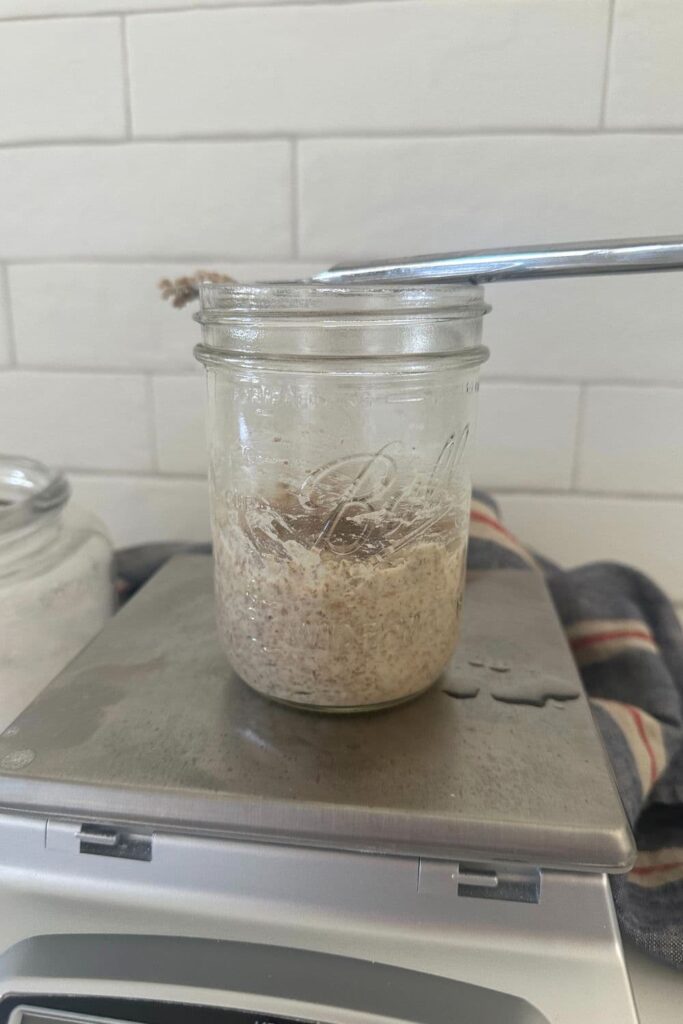
Why is there a layer of liquid on the top of my starter?
Sometimes you may get some dark liquid forming on top of or in the middle of your starter.
It’s called hooch and is perfectly normal. Just pour it off if you can – or mix it back in – and feed as per normal. You’ll find that your starter develops hooch when it is hungry.
Hooch will smell slightly alcoholic and is the result of the fermentation process. Mixing your hooch back in on a regular basis will create a more sour tasting starter.
In a new starter, your hooch will more than likely be a cloudy type liquid - it may look like the water has separated from your flour. This can happen if you aren't measuring your flour and water with a scale or if you are using more water than flour. To correct this, pour the water off, measure out 50g of starter and feed with 50g of flour and 50g of water. This will prevent the flour becoming over hydrated.
You'll find out how to prevent hooch in your starter here.
You can also read about what to do if your sourdough starter is too runny here.
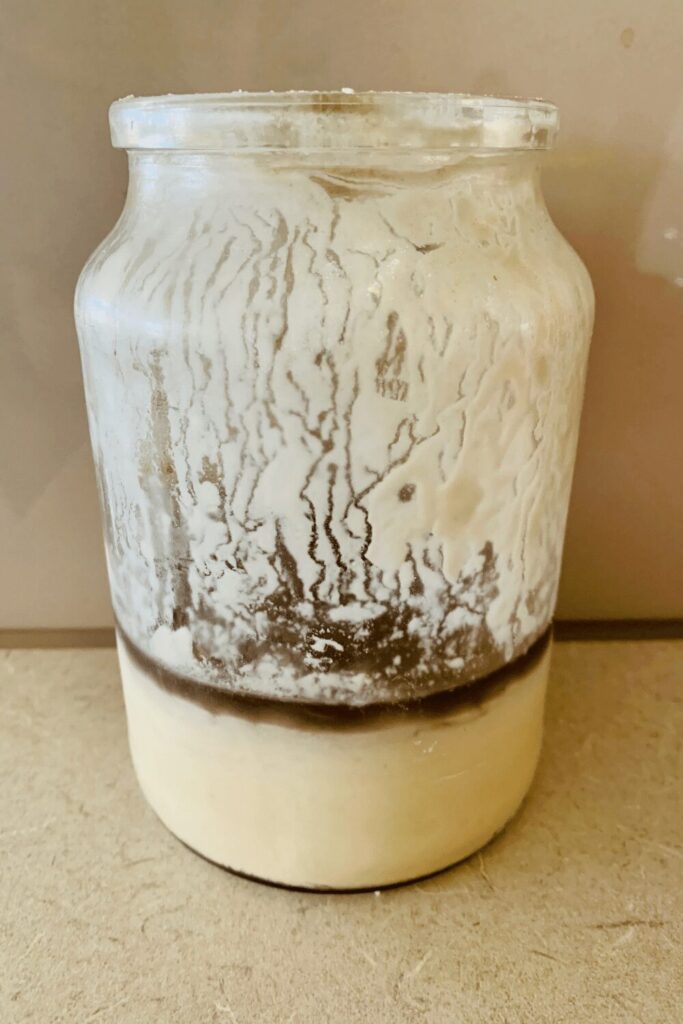
This sourdough starter has developed a dark layer of hooch after being neglected for quite a while. Even a sourdough starter in this condition can be revived - you can see how here.
Why does my starter smell like nail polish remover?
Sometimes your starter will develop an acetone or nail polish remover smell. It's perfectly normal, it’s just hungry, so feed, feed, feed.
You may find that your starter smells like this more in warmer environments.
If your starter is wanting to be fed more than twice a day, consider increasing your feeding ratio to 1:2:2 to give your starter more food or using some iced water to slow it down a bit.
It's normal for your starter to go through a period of smelling like this, but after a few feeds it should start smelling more yeast like.
My sourdough starter smells like old gym socks - why?
In the first few weeks, as the bacteria and yeast colonies are establishing themselves, your starter may smell really, really bad. And I'm not just talking a little whiffy.
You might find it smells anything from old gym socks, to vomit to pretty much anything in between.
This is completely normal in the first few weeks and it will settle down as the good bacteria take hold and overtake the bad bacteria. Once established, your starter should smell good - a fruity, yeasty smell should prevail.
If your starter is well established and has developed a bad smell, you can feed it a few times to refresh it.
Why isn't my starter bubbling like the first few days?
Occasionally starters start out strong and then taper off a little between days 3-7.
It’s ok and may just be that the good bacteria is taking a little longer to win. Just keep feeding it consistently and you should see some action.
Don't give up after a few days - have some patience and you will be rewarded. Your starter is definitely not dead, it's just new and still becoming established.
If you are worried, try stirring your starter in between feedings to encourage the oxygen levels in your starter. This will help the good bacteria and yeast to develop and flourish more quickly. You'll find more tips for boosting your sourdough starter here.
Also, make sure you're using a quality water source as some types of water can inhibit sourdough starter growth.
You can read more about what to do when your sourdough starter isn't bubbling here.
My Starter Doesn't Rise At All!!
This is one of the most common issues in creating a sourdough starter. Now before you panic, you first need to think about the age of your starter. It's common for a starter less than 2 weeks old not to have risen at all yet.
The other thing that can happen is that your starter is actually rising, but you're missing it (maybe you feed it in the morning and then go out to work, missing all the action). Look for residue on the sides of the jar that might indicate that your sourdough starter is actually rising and falling. Setting up a time lapse camera can also help with this issue.
The size of your jar might also be an issue. If your jar is too big, you might not notice that your sourdough starter is actually rising. You'll find a guide on the best jar for sourdough starter here.
Make sure you have a rubber band around the jar at the level where your sourdough starter sits when you feed it. Then you accurately see whether your starter is indeed rising, even a little bit.
Do I have to weigh the ingredients for my sourdough starter?
YES! Weighing is super important - and much more accurate than using cups and spoons. You'll find that your sourdough starter develops much faster if you weigh out your ingredients and feedings in grams. It will help you to avoid some of the most common sourdough starter problems later on.
You can read an in depth explanation of why weight is much more accurate than volume when it comes to sourdough here. You'll find a set of scales perfect for sourdough baking here.
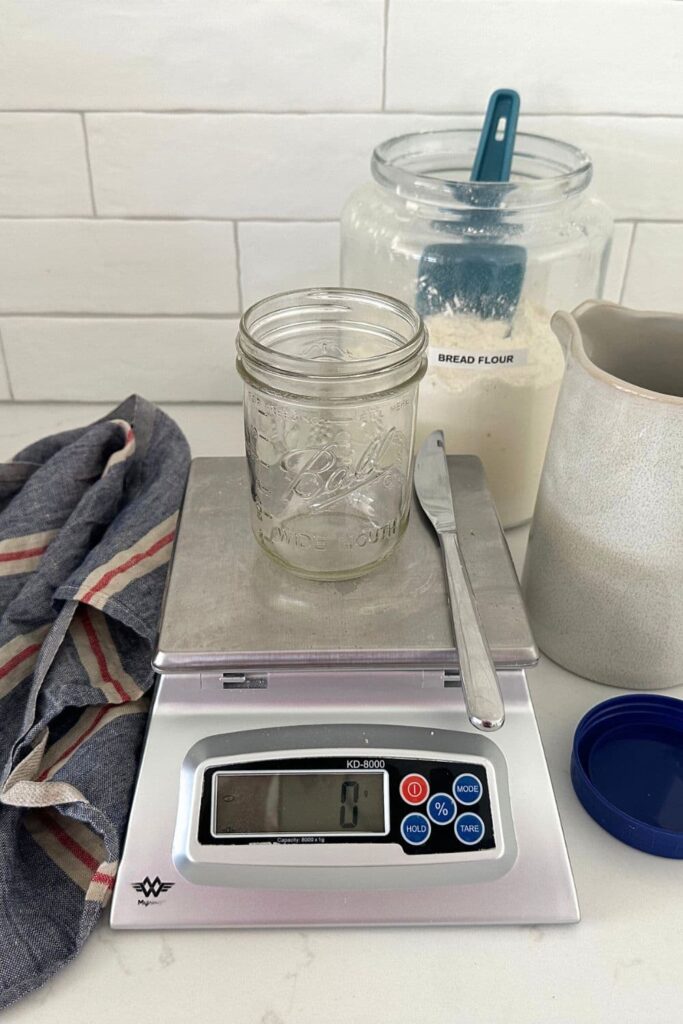
Do I have to discard every time I feed - I don't want to waste flour?
The short answer is YES, you must discard before each feeding. If you don't, your starter will grow exponentially and won't be getting enough food. It will then start developing hooch.
Did you know that discarding is actually less wasteful than not discarding - you can read more about why here.
I Can't Do Daily Feedings ... What Should I do?
If you are trying to establish a new starter, it's really important that you feed it twice a day (you can do once if it's really too difficult to feed twice, but twice a day is best).
If you aren't going to be able to refresh your developing starter daily, then I highly recommend you purchase a mature starter (remember, a sourdough starter is a living thing and thus needs regular nourishment).
An established starter will only need a few feeds to get it going and will be able to be stored in the fridge when you're unable to tend to it. This may be more convenient for you if you can't manage the daily feedings necessary for a new starter.
How do I keep my starter warm?
It’s not totally essential to keep it warm, it will still work – it will just take a lot longer in a colder environment. If your ambient room temperature is on the cooler side, you might want to look at ways you can warm your starter up, like feeding your sourdough starter with warm water, rather than cold water.
You'll find 20 ways to keep your sourdough starter warm here. Sourdough starters generally prefer warmer temperatures and will ferment better in a warm environment than a colder one. As a general rule, you want to keep your sourdough starter between 24C and 28C (75F and 82.5F).
Why is my sourdough starter forming a skin?
You'll find that your sourdough starter sometimes develops a crust or skin. It’s totally ok and just means that it’s getting a bit too dry on top.
Try using a jar lid (not screwed on) or even a piece of cling film. Just scrape the skin off and feed as per normal.
If it happens regularly, you may need to change where you're storing your starter.
What do I do if my starter goes moldy?
If your starter develops anything pink or orange or furry, it’s definitely time to ditch it and start again.
Make sure that your jar is super clean. If the mold happens a few times, consider using a different flour as sometimes the mold spores come from the flour and not the environment.
Some people believe that you can scrape some of the starter from underneath in order to "save" it, however, if there is mold on the surface or on the rim, the spores will be all the way through your starter.
Just ditch it and start again. This is non negotiable!
For a full guide to dealing with mold - how to prevent it and what it can look like - check out my guide to moldy sourdough starters.
Why Is There White Stuff Growing On My Starter?
Sometimes you will find a white film or white clusters that appear to be mold growing on top of your starter.
As long as they aren't fluffy (mold) they are more than likely to be Kahm Yeast.
Kahm Yeast is not desirable - but it's not dangerous either. It might make your starter taste a bit funky too.
To remedy the problem, take some starter from the middle of the jar (well underneath the Kahm layer) and transfer to a clean jar. Feed this as per normal.
Wash everything thoroughly to get rid of the Kahm yeast.
You'll find more information on Kahm Yeast here.
Should I transfer my starter to a clean jar every day?
No - it's better not to use a clean jar every single day. If your jar is particularly built up around the rim then pop your starter into a new jar when you feed it.
So you'd put 50g of starter starter into a clean jar and feed as normal (1:1:1).
But I believe that the old build up around your sourdough starter jar help to boost your sourdough starter microbiome. It gets stronger as it gets older. You'll find an old sourdough starter jar won't go moldy because the crusty build up keeps it safe. Try it!
To keep the jar clean, use a clean silicone spatula to scrape down the edges after a feed. You can read more about whether you should clean your sourdough starter jar here.
Can I feed my starter with different types of flour?
If you run out of the type of flour you started with, it’s ok to feed your starter with a different flour. If you just feed it once and then go back to the type you started with you shouldn’t have any issues.
If you are swapping the type of flour for all subsequent feeds then your starter may go through an adjustment stage as the levels of bacteria and yeast get used to their new food.
It will be fine, it just needs time to get used to it's new food. Don't throw it away. Just keep feeding - and make sure you're using unbleached flour. Whether you're swapping to whole wheat flour or rye flour, or maybe einkorn flour
I missed a feed - now what?
While it is important to feed your starter every 12 hours when you're trying to get it going, it's ok if you miss a feed. Life gets in the way of regular feedings sometimes, right?
Don't stress - and definitely don't start again. Just discard like normal - and then feed as you normally would. Your starter will be just fine!
Will whole wheat or rye flour make my starter bubble faster?
Yes - but you don't necessarily have to use them. You can create a strong starter from bread or all purpose flour (unbleached). It may just take longer.
Generally whole wheat and rye flour will bubble within a few hours because they have a lot of natural yeast in them. They will also help your sourdough starter to produce bigger bubbles.
If you think your starter is a little sluggish, you can feed them with whole wheat or rye to get them going, but you can also just wait a few more days for yours to bubble.
A starter made with whole wheat can look very different to one made with white or more processed flour. You can read more about creating a rye sourdough starter here.
Can I cook with my discard straight way?
The short answer is no - you need to wait until your starter is at least 7 days old. It will smell pretty bad in that first week anyway, so you more than likely won't want to use it!
You’ll find that it’s better once your starter is actually active. You'll find over 100 sourdough discard recipes here.
If I store my discard in the fridge, do I need to feed it?
Short answer, no you don't (because then it would be an active starter, right?). You can read about the differences between sourdough starter and sourdough discard here.
If you're storing your discard in the fridge, just remember that it's unfed so eventually it will go bad if you don't use it.
If you keep it for a while before you use it, you may find that it develops hooch (see above).
My starter got baked in the oven - is it dead?
Many people keep their starter in the oven (with the oven light on) to keep it warm and make it develop faster. This is a great idea - until someone else turns the oven on to preheat it without checking what's inside first.
Baked sourdough starter is probably a more common sourdough starter problem than you think.
If your starter is baked - depending on the severity - you can probably bring it back to life. As long as it wasn't completely baked through, try to resurrect it before you ditch it.
You'll find a guide to resurrecting your oven baked starter here.
Can I add commercial yeast to my starter to make it start bubbling faster?
Short answer - yes. However if you do this, you will not have a true sourdough starter, it's called a "poolish starter".
It is far more rewarding to be patient and wait for those wild yeast strains to populate your starter. I promise it's worth it! You can read about how to increase the wild yeast in your sourdough starter here.
If you're feeling particularly impatient, you could make this sourdough discard bread which uses both starter and commercial yeast.
You can read more about adding yeast to a sourdough starter here.
When will my starter be ready to bake bread with?
A super active sourdough starter that's ready to bake with will have some, if not all, of the following qualities:
- Is at least 14 days old.
- Bubbles breaking on the surface
- Visible bubbles on the side of the jar that peak 3-4 hrs after feeding.
- Doubled within a few hours after feeding.
- Honeycomb bubble network when you tip the jar and let the starter pour out.
- A slight dome shape on top signalling lots of rise.
- Honeycomb bubble network forming on the side of the jar
One of the best ways to ensure your starter is successful is time. You just have to have a little patience to create a healthy starter.
You can read a more in depth article about starter readiness here. Remember while your starter can be used to bake with after 14 days, it's not considered a mature starter until it's at least 3 to 4 months old.
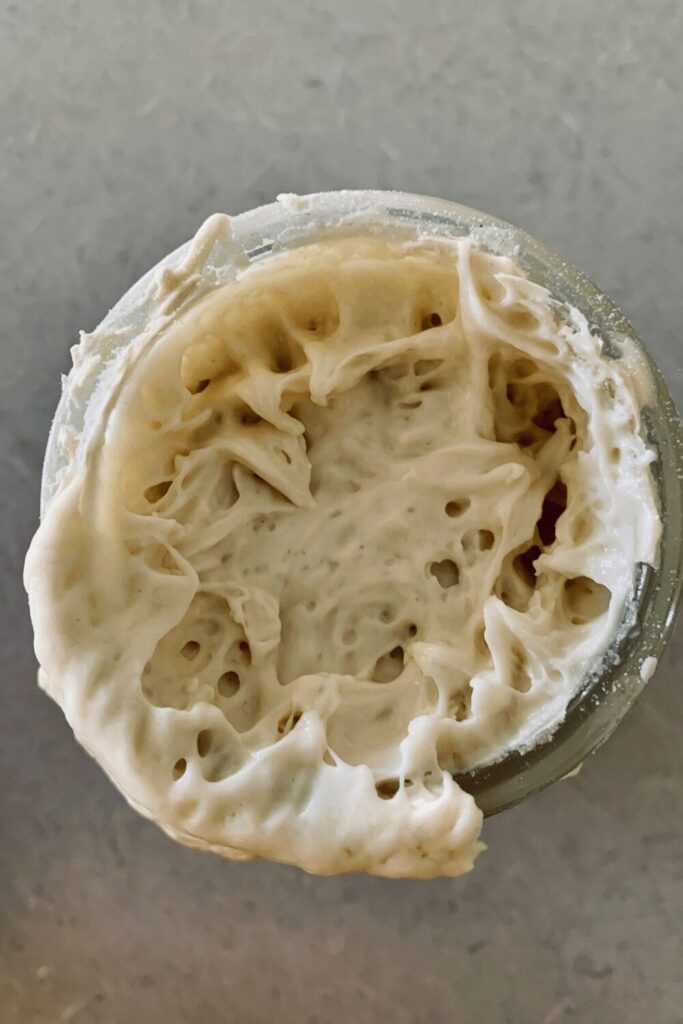
My Sourdough Starter Doesn't Float - Now What?
The float test is not the best way to test for sourdough starter bake readiness (you should use the points above).
The test can create false positives and negatives if not done correctly.
You can read all about the float test here.
How Do I Scale My Starter Up or Down?
Many people ask how you can increase (or decrease) the amount of starter in you jar. It's actually really easy to increase or decrease your starter once it's ready to bake with. You can go from just 50g of starter to 250g of starter with a simple calculation.
You can find instructions for scaling your sourdough starter and increasing the amount of starter in your jar here.
There Are Fruit Flies In My Sourdough Starter - HELP!
Having a sourdough starter in your kitchen can attract fruit flies. They may even get into your starter and be flying around in the jar.
Don't stress, it's not all bad and you can resurrect your starter. You'll find all the info on dealing with fruit flies here.
I hope this list of the most common sourdough starter problems helps you to navigate life with your sourdough starter.
I've Only Got Tap Water ... Should I Be Using Bottled Water For My Sourdough Starter?
It's best to use water with the least amount of chemicals and additives. This doesn't mean you can't use tap water. In some areas, the tap water is fine.
If you feel your tap water has a lot of chlorine or other additives, you might consider using filtered water or even bottled water, but it's not essential.
You can read my guide to the best water for sourdough starters here. It's important to avoid using distilled water and reverse osmosis water because they lack important minerals.
There's Condensation on the Sides of My Jar ... What Do I Do?
Sometimes condensation forms on the sides of your jar. Many people warn this can be dangerous (because it encourages mold), however, as long as you monitor the jar and you're feeding regularly then it should not be an issue, even if you are keeping your sourdough starter in the fridge.
Condensation doesn't tend to form if you're using a piece of cloth or paper towel to cover your jar, but if you use a lid, sometimes condensation can form.
Read more about which lid to use for sourdough starters here.
Should I Stir My Starter Before I Feed It?
It really doesn't matter whether you stir your sourdough starter before you feed - mostly because you are going to stir it once the fresh flour and water has been added anyway.
I like to give my starter a stir between feedings, as this ensures all the flour has been mixed through thoroughly and often makes my starter rise more quickly.


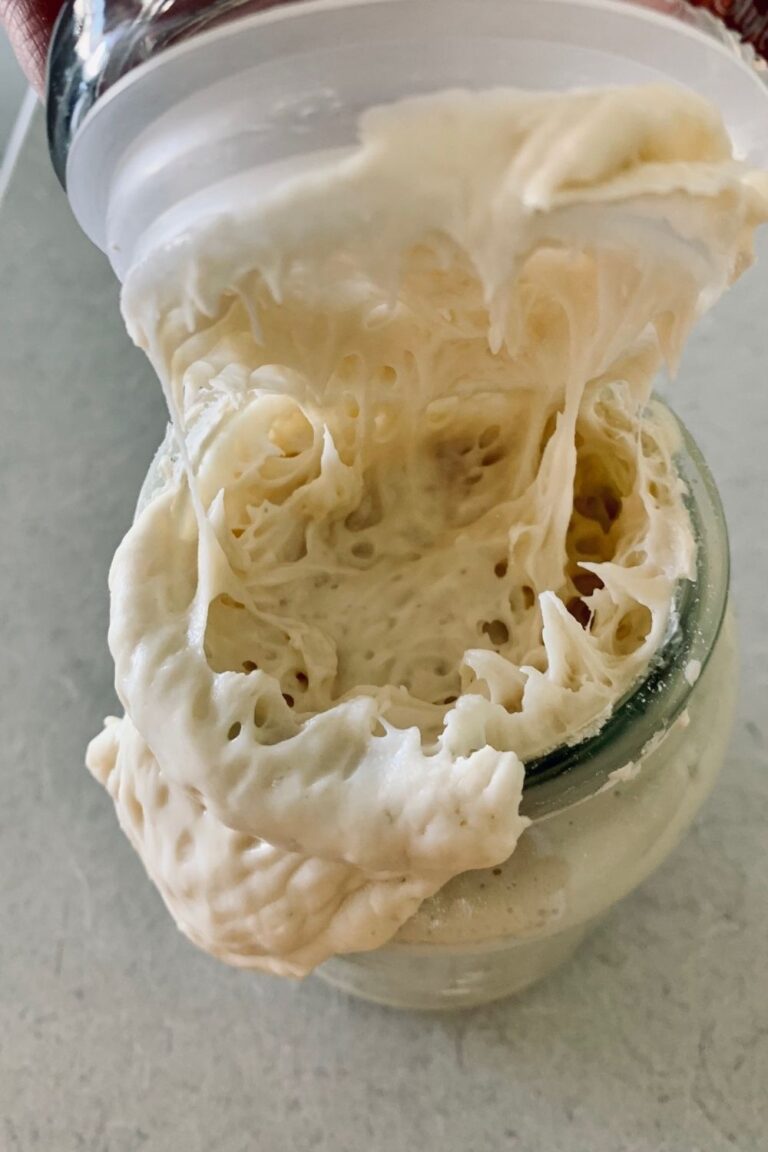
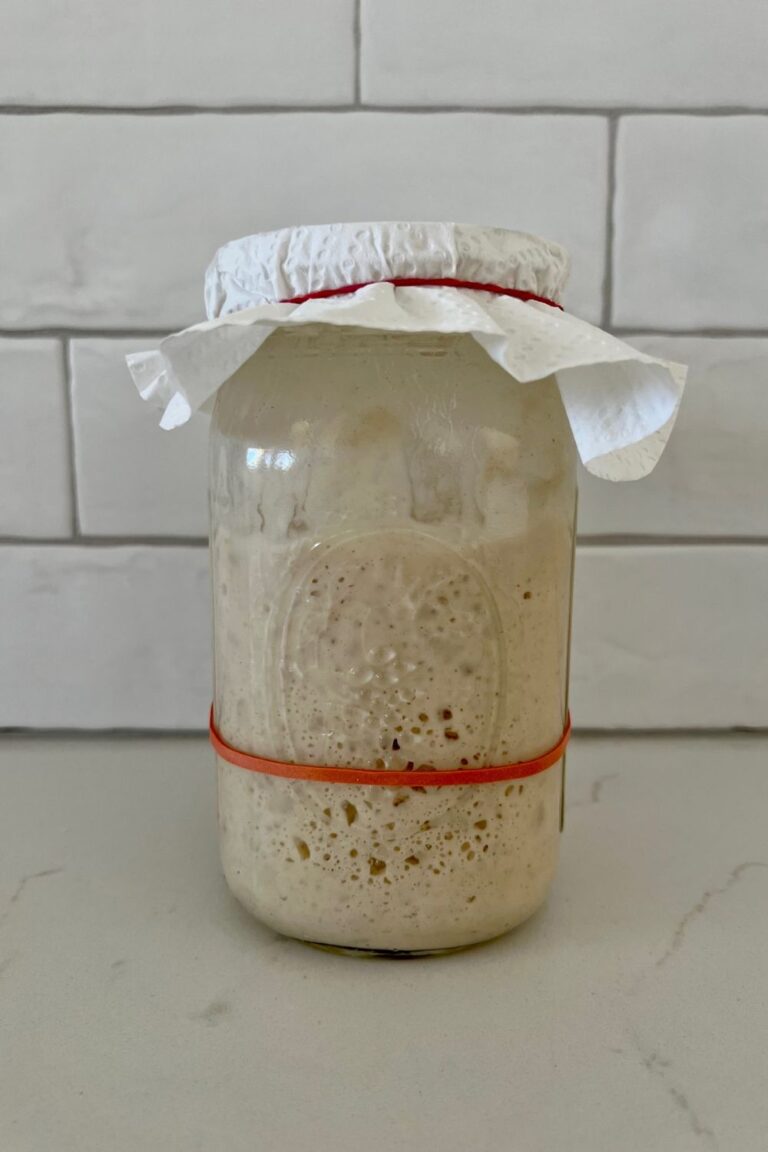
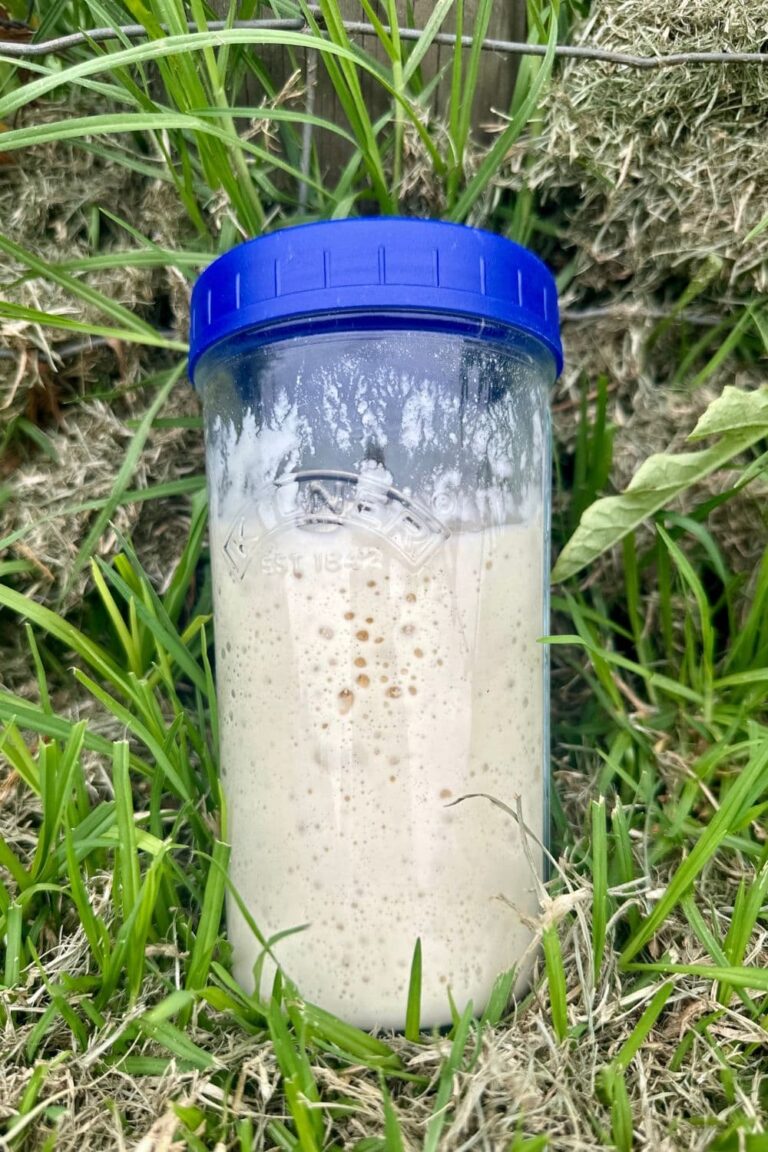
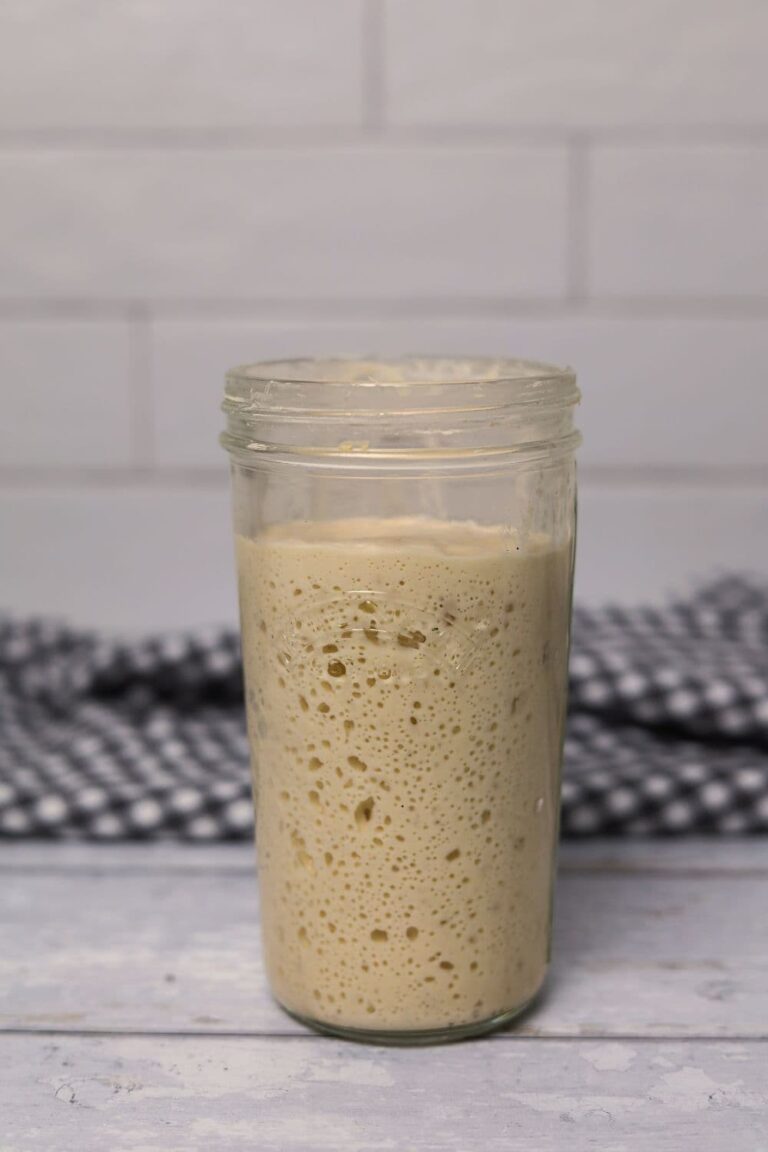

Great info but i have one question…use warm water. What temperature is “warm water” when feeding my starter? I usually use water that’s at 70 degrees F.
I have been feeding my starter for 50 days now (yes 50) and I absolutely cannot get it anywhere near doubling. The most I've gotten is 30% rise after 24 hours, but that was rare. It mostly sits flatly with just a few bubbles.
I started with rye and now I've moved it to all bread flour. I've tried every single tip I could find: weighing everything, warm 75°F area, bottled water warmed to 85°F for daily feedings. I tried increasing feedings, increasing the amount of flour, slowly changing flour, skipping feedings, keeping it in a dark area... It's absolutely maddening at this point. It is fragrant so obviously something is going on with it, but when I read tips about bubbling within 4 hours or doubling or honeycomb networks, I can only wistfully laugh.
I'd love to help you to get your starter thriving! What ratio are you feeding your starter at? For example 50g of starter, 50g of flour, 50g of water and how often (ideally twice a day). Let me know and I can give you some tips to get it going! TPM x
I took a class at a local farm. She only uses a stiff starter. We made some to take home and I have used it exclusively. Do you have any articles on working with it?
My problem is an odd one. My starter smells fresh!
No sour smell at all. It bubbles along nicely and does its job of bread rising fairly well. My bread is usually too compact. So I think the yeast must be weak.
After reading your page I'm going to do two things.
Pour off my hooch, and feed the starter more frequently, with Whole Wheat flour.
Thanks for all the information and I hope you can help with the 'fresh' smell
My starter hasn't risen in weeks; I can't find a warm spot to keep it in. Now it's got big clumps of flour on top looks like an island
Why does my starter have brown flecks in it? Do I have to start over?
I'm only on my day 7. Should I be feeding 2 times a day?
Absolutely you should be feeding twice a day 🙂
My starter is doubling and sometimes tripling, so I feel really good about using it to bake with now. But every time I put together a dough, it doesn’t rise and sits dense and a little sticky at the bottom. I’ve used less water and it’s still not rising. I do live in Florida but I’m not sure if the humidity would effect it this much.
Love all the info here, I could be happy curling up and spending the day reading. But I really need an answer to my question. My starter has been neglected most of the year. Between frozen water pipes, replacing windows in November instead of September, and gardening it has not been a good year for baking. I took out my starter and feed it 1:1:1. Put it in the oven with the door open (still dealing with an old drafty house) and went to bed. This morning it appears that it peaked during the night and deflated. Can I use it to bake with after it has deflated? Also I like my bread tangy how do I achieve that.
Thanks
My starter is about seven years old and it's going strong, but I have a question. Usually I store it in the fridge covered with a small glass pot lid, and I feed it every week or two. Mostly I just use the discard for muffins and such, but when I (very occasionally) make bread, I feed the starter and leave it out for a few hours. My question: when it's on the counter, should it be covered tightly, or loosely, or not covered at all? Thanks.
My starter is about 3 weeks old. I see in the instructions that it won't be "mature" until about 3-4 months. So do I just keep feeding it twIce a day all that time? That seems like a LOT of flour for twice a day for 3 months. Also I will be out of town for a week at the end of month 2.... Thanks for any info! So far, your instructions are spot on - I am seeing much better success than with other sourdough websites. Thank you!
I'm so glad you're having success 🙂 Yes you will need to feed your starter twice a day during this time, but you can reduce your starter down to as little as 20g if you prefer (just keep the 1:1:1 ratio). It's ok to put your starter in the fridge when you're going way. You can see what to do with it here.
My loaf looks beautiful. The crumb ‘looks’ good but it is petty tough.
I baked it to 110 degrees F.
500g bf
320g water
120 g active starter
10g salt
Hi Kate!
I’m new to sourdough bread baking. I have been baking bread using conventional yeast for years and have generally gotten good results. But I love sourdough bread, and I also love a challenging project, so I set forth to create a sourdough starter and try my hand at baking sourdough bread.
I quickly discovered that one of the problems for a novice sourdough baker is that, while there is a great deal of information on the Internet about sourdough starters and baking, much of it is confusing, complicated, or contradictory.
I found a sourdough recipe using sliced grapes to provide the necessary wild yeast.
I got a nice, bubbly, and very active sourdough starter, but after starting to use it after just four days, the two loaves of sourdough bread I made didn’t rise very much, and were dense and hard. To say that I was disappointed is putting it mildly. I decided to go back to the drawing board and begin again with a new batch of sourdough starter. I also went back on the Internet to search out SOMEONE who REALLY knows sourdough. Luckily I found your website and Facebook page, and I am so very glad I did!
Your insightful knowledge about sourdough starters and sourdough baking was both inspiring and reassuring. Your tips about how to deal with a sourdough starter that seemed dormant were spot on and incredibly useful. I took your advice and added some rye flour to my “dormant” sourdough starter and it magically sprang back to life almost immediately! I am also stirring my starter a couple times between feedings to get more oxygen into it, as you suggested. I am also patiently feeding my starter twice a day and giving it the time it needs to mature and get well established. My starter needs at least another week to develop to the point that it will hopefully deliver better results in the baking.
I signed up for your newsletter and Facebook page, and look forward to reading more about the challenging fine art of sourdough starter creation and sourdough bread baking.
Thank you so very much for sharing your thoughts, wisdom, experience, and enthusiasm with the community of bread bakers who want to bake beautiful loaves of sourdough bread!
I thought my starter had risen enough (about double) and got my dough ready for a "bulk rise". It has been over 10 hours and it has barely moved. Any way to revive this? Or do I make "croutons" with this batch.
The time it takes to rise will depend on how much sourdough starter you've used and how warm your dough is. If you've used a small amount of starter and/or it's cold in your home the dough can take a very long time to rise. I'd try to warm the dough up a bit and see if that helps 🙂